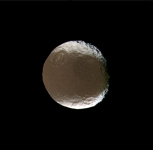
|
Iapetus Spins and Tilts
- Click the image above for a larger view
 Movie Download Options
Movie Download Options- Full-Res JPEG (618 x 605) (18.9 kB)
- Full-Res TIFF (618 x 605) (1.1 MB)
Caption:

Click on image for Iapetus Spins and Tilts Movie
Saturn's two-faced moon tilts and rotates for Cassini in this mesmerizing movie sequence of images acquired during the spacecraft's close encounter with Iapetus on Nov. 12, 2005.
The encounter begins with Cassini about 850,000 kilometers (530,000 miles) from Iapetus. Cassini approached over the moon's northern hemisphere, allowing for excellent full views of a 575-kilometer-wide (360-mile) impact basin in northeastern Cassini Regio. Astronomer Giovanni Cassini discovered the light and dark faces of Iapetus' two hemispheres (among his other Saturn discoveries), and the dark region. The spacecraft also bears his name.
Also prominent in these images is a 380-kilometer-wide (235-mile) basin to the northwest of the larger basin, in the transition zone between Cassini Regio and a brighter region called Roncevaux Terra, with its 150-kilometer-wide (95-mile) crater Roland (at the top, with a prominent central peak).
The movie takes Cassini to its closest approach, at about 415,000 kilometers (260,000 miles) from Iapetus, and then looks back at the moon's receding crescent. The sequence ends with Cassini at a distance of about 460,000 kilometers (285,000 miles) from the moon.
Iapetus is 1,468 kilometers (912 miles) across.
Images taken using ultraviolet, green and infrared spectral filters with the Cassini spacecraft narrow-angle camera were combined to create false-color frames for this movie. The color seen here is similar to that produced in (red, green and blue) natural color views. Resolution in the original images taken at closest approach to Iapetus was about 3 kilometers (2 miles) per pixel. The color frames were resized to create the movie.
Background Info:
The Cassini-Huygens mission is a cooperative project of NASA, the European Space Agency and the Italian Space Agency. The Jet Propulsion Laboratory, a division of the California Institute of Technology in Pasadena, manages the mission for NASA's Science Mission Directorate, Washington, D.C. The Cassini orbiter and its two onboard cameras were designed, developed and assembled at JPL. The imaging operations center is based at the Space Science Institute in Boulder, Colo.
For more information about the Cassini-Huygens mission visit http://saturn.jpl.nasa.gov . The Cassini imaging team homepage is at http://ciclops.org .
Cataloging Keywords:
| Name | Value | Additional Values |
|---|---|---|
| Target | Iapetus | Saturn |
| System | Saturn | |
| Target Type | Satellite | Planet |
| Mission | Cassini-Huygens | |
| Instrument Host | Cassini Orbiter | |
| Host Type | Orbiter | |
| Instrument | Imaging Science Subsystem (ISS) | |
| Detector | Narrow Angle Camera | |
| Extra Keywords | Color, Crater, Impact, Infrared, Movie, Rotation, Ultraviolet, Visual | |
| Acquisition Date | ||
| Release Date | 2005-12-06 | |
| Date in Caption | 2005-11-12 | |
| Image Credit | NASA/JPL/Space Science Institute | |
| Source | photojournal.jpl.nasa.gov/catalog/PIA07766 | |
| Identifier | PIA07766 | |
